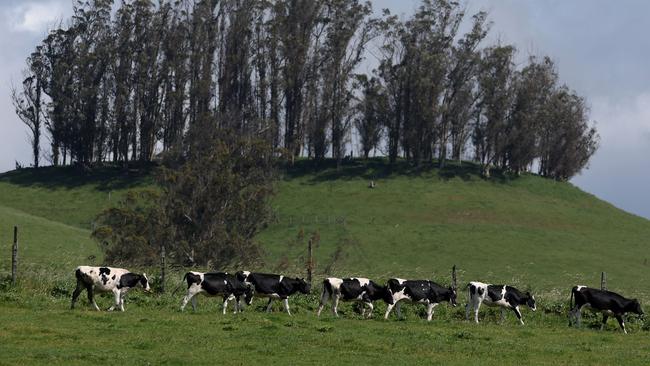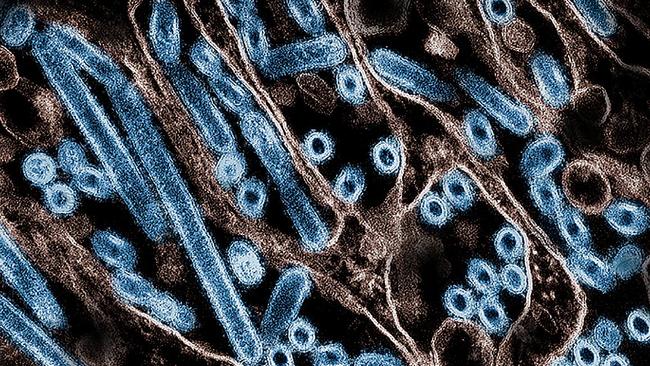Concerns H5N1 strain of bird flu ravaging US farms could become new pandemic
Experts have raised a “red flag” over a concerning situation unfolding across the US.

Illness
Don't miss out on the headlines from Illness. Followed categories will be added to My News.
A new study has flagged the potential for a strain of bird flu to become the next human pandemic, after a string of infections across the US.
There have been almost 60 human cases of the H5N1 bird flu virus across seven states this year in America, where authorities are concerned about outbreaks on dairy farms.
The study published in Science has found a single mutation of the H5N1 strain could allow it to bind more effectively with human cells, something that would normally take multiple mutations to occur.
“When you think about mutations happening in nature, to get three is statistically really hard,” James Paulson, co-senior author of the study, told Newsweek.
“But it’s orders of magnitude easier to get one. And so that’s the red flag that says we really need to keep paying attention to what’s going on.”

The study tested an amino acid mutation, dubbed Q226L, in a laboratory setting and found a significant shift in the virus’s ability to attach to human-type receptors.
“The findings demonstrate how easily this virus could evolve to recognise human-type receptors,” the study’s first author Ting-Hui Lin said in a statement.
“However, our study doesn’t suggest that such evolution has occurred or that the current H5N1 virus with only this mutation would be transmissible between humans.”
The strain has not yet been identified in Australia but has been detected in countries around the world.
The World Health Organization (WHO) in November urged countries to step up surveillance for bird flu after the first case was detected in a child in the US.

A small but growing number of H5N1 avian influenza infections have been detected in humans around the world in recent years, WHO epidemic and pandemic preparedness and prevention director Maria Van Kerkhove said.
“What we really need globally, in the US and abroad, is much stronger surveillance in animals: in wild birds, in poultry, in animals that are known to be susceptible to infection, which includes swine, which include dairy cattle, to better understand the circulation in these animals,” she said.
More than 700 dairy herds across the US have tested positive for bird flu across 15 states, the majority have been in California, the nation’s largest dairy producing state.
The US Department of Agriculture has announced mandatory testing of milk samples will begin this month as authorities attempt to limit the virus’ spread.
“Among many outcomes, this will give farmers and farmworkers better confidence in the safety of their animals and ability to protect themselves, and it will put us on a path to quickly controlling and stopping the virus’ spread nationwide,” Agriculture Secretary Tom Vilsack said.

H5N1 first emerged in 1996 but since 2020, the number of outbreaks in birds has grown exponentially, alongside an increase in the number of infected mammals.
The strain has led to the deaths of tens of millions of poultry, with wild birds and land and marine mammals also infected.
Human cases recorded in Europe and the US since the virus surged have largely been mild.
In March, infections were detected in several dairy herds across the US.
US health officials believe the risk for the general public is low – albeit higher for those working directly with livestock animals including birds, dairy cattle and more.
In Novemnber, US authorities said a child in California had become the first in the country to test positive for bird flu infection. Health officials offered checks and preventive treatment to exposed contacts at the child’s daycare centre.
The child had mild symptoms and was said to be recovering at home following treatment with flu antivirals.

“Including this most recent case, 55 human cases of H5 bird flu have now been reported in the United States during 2024, with 29 in California,” the US Centers for Disease Control and Prevention said.
There have now been 58 human cases identified in the US.
Ms Van Kerkhove said all but two of the 55 cases identified to November 28 had known exposure to infected animals.
“We have not seen evidence of human-to-human infection. But again, for each of these human detected cases, we want to see a very thorough investigation taking place,” she said.
“We need much stronger efforts in terms of reducing the risk of infection between animals to new species and to humans,” she added, notably through testing and proper protective equipment.
Ms Van Kerkhove, who was the WHO’s Covid-19 technical lead, stressed the importance of preparing “for when or if we will be in a situation where we are in a flu pandemic”.
“We’re not in that situation yet, but we do need more vigilance.”
More Coverage
Originally published as Concerns H5N1 strain of bird flu ravaging US farms could become new pandemic




